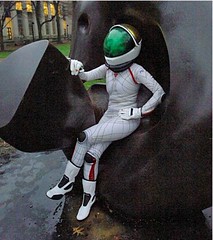Ah, the power and the limits of Internets. Incomplete information at your fingertips!
A modest splash was made last week courtesy of the MIT press machine. They're working on a new space suit, one that uses mechanical counter-pressure, solves problems that the current pressure suits used by NASA have.

What the bleep, NASA. Asleep at the switch, again? Need a little pick-me-up from someone playing outside the box?

Well, yes. And no. Like anything it's complicated and somewhat tedious. What follows is highly condensed and subjective. Readers are encouraged to think for themselves. Links at the bottom may help.
Gas-pressure suits have Issues. Mobility isn't the best. It takes forever to put on a suit. They're more expensive than my house, more complicated to operate than an M1A2 and takes a ginormous amount of energy just to pick up a pair of pliers.
All in all they're 'ok' for mission that is planned to the nth detail, years in advance. Not so good if you're going to have thousands of guys building stuff in space. Enter the Space Activity Suit and the follow-on effort, Bio-Suit.
The idea behind mechanical counter-pressure suits have been around for a long time. Your body - yes the one you're wearing right now - is almost good enough. You just need to apply pressure all over to make it work in space.
Excellent! But there are issues.
Yow. Despite that Progress was made and the program was terminated. Technology that just didn't work? Bureaucracy? What the heck is going on here?
Jim Oberg mentions that the guys at JSC debunked the concept.
Done, not worth pursuing.
Jerry Pournelle reports that NASA didn't investigate the idea in any serious way. The initial SAS studies were underfunded, politics trumped what was best and that is that.
There may be some ax-grinding going on here. Or not - it's not like Doctor Pournelle has a career riding on the outcome and I've generally gotten the impression he's a straight arrow about this kind of thing.
My own semi-informed opinion is that what was not possible in 1970 might be possible now. NASA does have bureaucracy problems and ditching the old and proven for the new and untried is not going to be easy in that environment.
Space Activity Suit - Encyclopedia Astronautica
Bio-Suit - Encyclopedia Astronautica
A modest splash was made last week courtesy of the MIT press machine. They're working on a new space suit, one that uses mechanical counter-pressure, solves problems that the current pressure suits used by NASA have.

What the bleep, NASA. Asleep at the switch, again? Need a little pick-me-up from someone playing outside the box?

Well, yes. And no. Like anything it's complicated and somewhat tedious. What follows is highly condensed and subjective. Readers are encouraged to think for themselves. Links at the bottom may help.
Gas-pressure suits have Issues. Mobility isn't the best. It takes forever to put on a suit. They're more expensive than my house, more complicated to operate than an M1A2 and takes a ginormous amount of energy just to pick up a pair of pliers.
All in all they're 'ok' for mission that is planned to the nth detail, years in advance. Not so good if you're going to have thousands of guys building stuff in space. Enter the Space Activity Suit and the follow-on effort, Bio-Suit.
The idea behind mechanical counter-pressure suits have been around for a long time. Your body - yes the one you're wearing right now - is almost good enough. You just need to apply pressure all over to make it work in space.
In the 1971 program ten successively refined prototypes of the suit were built, including 13 hours of wear by test subjects in vacuum chambers of up to 2 hours 45 minutes duration. The tests showed no significant problems in comparison to conventional suits. But whereas the energy cost of simple tasks in the Gemini or Apollo suits was typically 2.26 times that for a nude subject, in the SAS it was 1.64 times. And the mass of the suit, was half that of the Apollo suit.
Excellent! But there are issues.
... the tests also showed the major detailed technical challenges of completing development of such a suit. Most important was swelling/edema in parts of the body. To prevent blood pooling, the pressure across these regions needed to remain smooth. The most difficult areas to accomplish this in the crotch.
Yow. Despite that Progress was made and the program was terminated. Technology that just didn't work? Bureaucracy? What the heck is going on here?
Jim Oberg mentions that the guys at JSC debunked the concept.
This is what the spacesuit guys at JSC told me back in the 1970s, when the
concept had already been invented -- and debunked -- several times.
Done, not worth pursuing.
Jerry Pournelle reports that NASA didn't investigate the idea in any serious way. The initial SAS studies were underfunded, politics trumped what was best and that is that.
First: the "investigations" didn't lead to much in the way of publications, did they?
Second: the Space Activity Suit is one candidate for a work suit; it may well not be the right choice for the standard EVA suit. It may, on the other hand, be very much the right choice for an emergency inspection suit. They have to be cut to fit and one might not carry more than one, but having a flight engineer able to go out and inspect might have saved Columbia.
Third: NASA hasn't "investigated" alternatives to the present low pressure pure oxygen suits. There was some activity at Ames, underfunded, and when that looked like paying off, the turf wars saw to it that nothing would happen. The Ames suit developed by Webbon and Vykukal was far more suitable for EVA but despite a successful demonstration that it could be worn pressurized for hours without fatigue, no serious "investigation" was done.
Were the people you asked employees of Hamilton Standard? Did they include the executive who tried to get McGraw Hill to fire me for my BYTE column about the computers in the Ham Standard space suits? Just curious.
There may be some ax-grinding going on here. Or not - it's not like Doctor Pournelle has a career riding on the outcome and I've generally gotten the impression he's a straight arrow about this kind of thing.
My own semi-informed opinion is that what was not possible in 1970 might be possible now. NASA does have bureaucracy problems and ditching the old and proven for the new and untried is not going to be easy in that environment.
Space Activity Suit - Encyclopedia Astronautica
Bio-Suit - Encyclopedia Astronautica